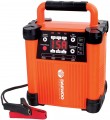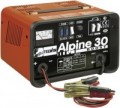Type
—
Transformer. The design of such devices is based on a transformer with a rectifier, operating on the principle of electromagnetic induction. It converts alternating power from the network into a small direct power for charging the battery. Transformer chargers are distinguished by increased reliability, simple design and low cost. At the same time, they have large dimensions and solid weight.
—
Pulse (inverter). Pulse (inverter) chargers affect the battery by supplying high-frequency pulses of low-amperage power. Using pulse chargers, it is possible to supply both direct and alternating power; sometimes they are used for mixed or combined charging of batteries. The vast majority of such chargers operate in an autonomous mode with automatic parameter control. Also, pulse chargers are many times more compact and lighter than transformer counterparts, but they are more expensive.
Battery compatibility
The parameter determines
compatibility with batteries, that is, with what types of batteries a charger or start-charger or a car booster can be used. Incorrect charger operation mode promises overcharging of the battery, its swelling and failure.
WET / EFB (Lead-Acid). The abbreviation WET is used to designate traditional lead-acid batteries with a liquid electrolyte. EFB (Enhanced Flooded Battery) is their improved subtype with thicker pure lead plates and a positive electrode in a special microfiber envelope. Both transformer devices and most impulse batteries are suitable for charging acid batteries.
AGM. In the design of AGM batteries, the electrolyte is in an absorbed state: the compartments of such a battery are filled with porous fiberglass material, which contains acid. This type of battery is particularly sensitive to overcharging - it is necessary to select a suitable charger with a certain set of automatic functions for it.
gel. In gel batteries, the electrolyte is brought to a jelly-like state with the help of special thickeners. The key to choosing the right GEL battery charger is the ability to vary the amount of charging current depending on how badly the battery is discharged.
LifePO4. Lithium iron phosphate batteries are charged with constant voltage an
...d current. As the voltage in the battery approaches the maximum value, the charge current should decrease, and after the end of the charging process, its supply should stop completely. To keep LiFePO4 batteries in good shape, devices with appropriate automatic functions are suitable.
Li-Ion. Lithium-ion Li-Ion batteries are charged in the same way as lithium-iron-phosphate counterparts. For them, you will need to pick up an automatic device with the ability to supply constant voltage and current.Battery voltage
The nominal voltage of the batteries that the device can work with. For boosters (see "Type"), in this case, the voltage that the "starter" can output at the output in the engine start mode is indicated.
-
6 V. Voltage found in some motorcycles, scooters, ATVs and similar vehicles.
-
12 V. Standard voltage of batteries (and on-board networks) for passenger cars, as well as light trucks and minibuses.
-
24 V. Voltage used mainly in trucks, buses and other heavy equipment. Also found in some heavy SUVs.
Min. charging current
The smallest current that the charger can provide in charging mode. See "Maximum charging current.
This parameter in our catalog is indicated only for those models that have several current adjustments (see below).
Max. charging current
The highest current that the charger can provide in charging mode. For models with one current adjustment (see below), its value is also indicated in this paragraph.
Different battery models may differ in charging parameters, including over the optimum current range. Accordingly, it is worth choosing a charger in such a way that it matches this range. Detailed selection recommendations can be found in special sources — in particular, documentation for batteries.
Battery capacity 12V
The capacity of batteries with an operating voltage of 12 V, for which a starter charger can be used. As a rule, modern units are not designed for one specific value, but for a range of capacities, which greatly facilitates the search filter according to the required parameters.
Note that although the discrepancy between the rechargeable battery in terms of capacity is not as critical as in terms of current or voltage, this does not mean that this parameter should not be paid attention to. Both too capacious and too “small” a battery will cause the charger to work in an off-design mode, which is harmful to both the “charger” and the battery, and can even lead to accidents.
Features
-
Voltmeter. A device that measures the operating voltage of a device. The specific purpose of such a device depends on the type of device (see above) and the format of its application. So, when starting, the voltmeter usually displays the voltage at the output of the device, and when charging, it can monitor the power voltage of the battery. In any case, this function provides additional information about the operating parameters.
-
Ammeter. A device that measures the amount of power supplied by a device. Most often, this function is used when charging batteries, to control process parameters. However, there are devices that allow you to monitor the power in the process of starting the engine.
-
Charging indicator. A pointer that displays the charge level of the car battery connected to the device. The specific device and functionality of such an indicator may be different: in some models it only signals the end of charging, in others it allows you to track the charge level throughout the entire process and even determine the approximate time until the end. Be that as it may, such an indicator makes it easier to follow the charging procedure - in particular, it allows you to accurately determine when the process is completed and the battery is ready for use.
-
Recovery (desulfation). Recovery mode for lead
...-acid battery plates covered with crystalline deposits of sulfates. Note that the deposition of sulfates in itself is a normal process that occurs when the battery is discharged; when charging, these deposits, which have a porous structure, are destroyed. However, if the battery has been stored in a discharged form for a long time, sulfates turn from a porous form into a crystalline one, and ordinary charging is unable to destroy them. As a result, the performance of the battery deteriorates significantly, up to complete unusability. Recovery mode is used to eliminate such deposits. Its essence lies in the fact that pulses of a specially selected format are applied to the battery, which destroy the sulfate layer and restore the properties of the battery.
- Overcharge protection. Rechargeable battery protection from overcharging - situations when a battery charged up to 100% continues to be under power. This situation leads not only to excessive power consumption, but also to damage to the battery. To avoid this, many devices provide for automation that turns off the output voltage at the end of the charge. This noticeably “simplifies life” for the user: there is no need to constantly monitor the process, it will end on its own at the optimal moment.
- Battery status test. Possibility to check the condition of the battery. The specific set of tools and testing capabilities may be different, it should be specified separately; among the most popular options are power voltage test, charge level test, starting power test, cold start test. Be that as it may, this function can be very useful for general preventive diagnostics, and for checking the condition of the battery before charging.
- Winter charging mode. Specialized mode for charging the battery at low ambient temperatures. Under such conditions, the properties of batteries change somewhat, and a strong charge power can lead to sudden heating and damage to the battery. In light of this, it is worth using specialized devices to charge the battery in cold weather.
- Battery storage mode. An operating mode designed for long-term storage of batteries. In this mode, the device is constantly connected to the battery, it monitors the level of charge and periodically recharges the battery with low currents, keeping it in a state of constant readiness and preventing loss of performance.
- Power supply 12 V (supply mode). An operating mode in which the device serves as a constant 12 V power source and allows you to disconnect the battery without losing important settings on the car's on-board computer. However, this mode can also be used outside the car - when it is turned on, the device acts as a conventional 12 V power supply.
- Fast charge timer. Timer counting down the time in fast charging mode. This mode, in accordance with the name, allows you to reduce the time to charge the battery, however, fast charging is carried out at high currents, due to which even a small overcharge can lead to unpleasant consequences. And it is impossible to provide protection against overcharging in the traditional way (see above) with such a procedure for a number of technical reasons. In light of this, devices with a fast charging function provide a timer that counts down the time and gives a signal at the end of the process; some models may also have automatic power off.
- Remote start button. The engine start button, located separately from the body of the starting charger and connected to it with a wire of a rather long length. This button allows you to control the operation of the "launcher" at a distance - for example, sitting in the cockpit. This feature is especially useful when working with heavy equipment such as trucks or buses, where the cab can be located at a considerable distance from the hood.
